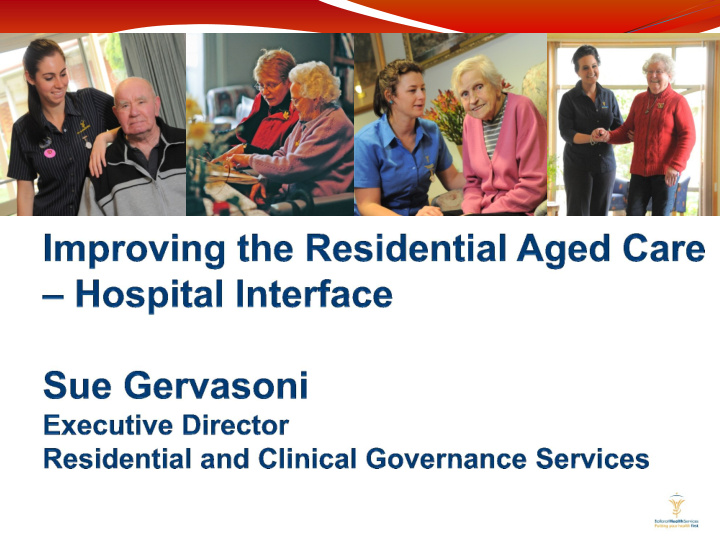



Why is it important? Public healthcare: finite resources mismatch demand vs capacity Whole of health approach to facilitate patient journey Resident - patient safety and quality of care Peak bodies such as NACA recognise the need for aged care, disability, community and health care systems to align to ensure seamless transition and care that best supports needs (blueprint series 2015)
Ballarat Health Services context Large Regional Health Service Acute : 221 beds Subacute: 70 beds Mental Health: 67 beds Residential Aged Care: 444 beds Community Programs
Residential Aged Care 10 facilities over 5 sites 240 beds are operated as High Level Care (HLC) Registered and Enrolled Nurse workforce Nursing EBA ratios 194 beds are operated as Low Level Care (LLC) 3 Tiers of workforce Not regulated by the nursing EBA 20 Beds Aged Persons Mental Health 10 Transition Care Program beds 5 Restorative Care
Progression of Care Key players in the room / address internal silo’s Common purpose Access to care: “Right Patient, Right Place, Right Time” Identify key access issues utilising real time data Problem solve Dispel myths based on data and evidence
“Patients' waiting for Nursing Home placement are blocking beds”
What did we find? 45 ACAS assessments undertaken on Acute site annually Admissions from Acute to BHS RAC 13 patients 2013-14 (days waiting placement 20) 12 patients 2014-15 (days waiting placement 35) Admissions from Subacute to BHS RAC 38 patients 2013-14 (days waiting placement 38) 35 patients 2014-15 (days waiting placement 39)
Outcomes Raised awareness of staff to RAC environment Respite days utilised Social Workers engaged early, support asset assessment. TCP use
Transition Care Program (TCP) Admission Source Ballarat TCP 45 40 35 30 25 20 15 10 5 0 Ballarat - Acute Ballarat -Sub-Acute 2013 -2014 40 30 2014-2015 34 33
TCP outcome data Discharge Destination From TCP Grampians Region 80 70 60 50 RAC % 40 HOME 30 20 10 0 2012-2013 2013-2014 2014-2015
Hospital occupancy demand
Aim to reduce avoidable presentations to ED Residential In-Reach Program (NPC Candidate) Advanced assessment and interventions: to prevent presentation to ED along with education and clinical support for nursing staff Acute management plans: prevent presentation to ED Stop and Watch Program
Stop and Watch Early warning tool Recognise early stages of deterioration Flag need for nursing intervention earlier Easy to use for non- registered staff (PCA) Interact 2
Referrals to RIR Residential Referrals each year 250 193 200 172 2011-2014 150 135 118 100 50 0 2011 2012 2013 2014
Reason for RIR referral Total Treating Conditions % DEMENTIA ENDOCRINE DISORDER 2% OTHER 2% 2% CVS 19% INTEGUMENTARY SYSTEM 15% GIT RENAL/URINARY SYSTEM 15% 12% FALL 4% RESP PAIN 3% 22% HAEMOTOLOGICAL 4%
ED Presentations from RAC 180 ED PRESENTATIONS 160 41% admit 140 120 40% admit 100 94% admit 75 % admit 80 60 40 20 0 2010-2011 2011-2012 2012-2013 2013-2014 2014-2015 Low Level Care High Level Care
Emergency Department Presentations
Resident days in hospital Hospital Leave Days 2,000 1,800 18-25% reduction in bed days 1,600 B A 1,400 S E 1,200 L I 1,000 N 800 E 600 400 200 0 2010-2011 2011-2012 2012-2013 2013-2014 2014-2015 YTD
Days in hospital by care level Hospital Leave Days by Care Level 1,600 1,400 1,200 1,000 800 600 400 200 0 2010-2011 2011-2012 2012-2013 2013-2014 2014-2015 YTD Total Days Low Level Total Days High Level
End of Life Framework Advance Care Plans introduced 2010-2011 Target > 85% residents to have ACP in place. Respecting Patient Choices via Austin Hospital Train the trainer model
Goals of Resident Care Completed by GP Resident, MEPA, family, involved. Guide decisions relating to care & treatment such as transfer to hospital or use of life prolonging interventions Dynamic and reviewed Trigger commencement CDMP Transferable to Acute
Care of Dying Management Plan Replaced the Liverpool Care Pathway Evidenced based care plan for the dying Implemented in the last days of life
Conclusion Progress in understanding and improving interface of RAC and the Acute hospital. Key areas to continue to develop include Avoidable presentations to ED Staffing models in traditional LLC facilities Evaluation of the GOC Information and understating of staff outside the RAC
Recommend
More recommend